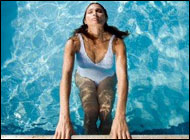New guidelines for healthy swimming
The World Health Organization (WHO) is launching the world’s first-ever international guidelines on how to create safe places to swim and bathe.
The guidelines aim to protect people from the risks associated with swimming pools, spas and other recreational bathing areas.
Globally, swimming, bathing and spas are becoming more popular. However, as more people use water for recreation, poor design, maintenance, management and use of these areas increase the risk of spinal injuries, disease and even death. Accumulating evidence and experience shows that many of these accidents and much of this disease can be prevented through simple measures.
WHO’s new guidelines give state-of-the-art information on how to ensure swimming pools, spas and other recreational bathing areas are safe. The Guidelines for Safe Recreational Water Environments: Swimming Pools and Similar Environments include both specific values for contaminants and a set of recommended best practices to support safe management and use of recreational waters, pools and spas and prevent unnecessary disease and injury.
They address a wide range of hazards, including the improper use of recreational facilities and how improvement could prevent drowning and injury; risks from poor water quality; the contamination of facilities such as pools and hot-tubs; and air quality in indoors bathing facilities.
The Guidelines point towards simple, achievable measures that have been shown to be effective in protecting health. These include: effective supervision by lifeguards, which can mitigate or prevent a range of health problems; better water quality and ventilation management, which can control exposure to toxic chemicals; and improving the way children’s ‘accidental faecal releases’, and the outbreaks of disease which they can cause, are dealt with. 
“We are seeing an ever-greater use of rivers, lakes, pools, spas and other bathing facilities, worldwide and year-round, in both developing and developed countries. While in principle this is a positive development from the health perspective, unfortunately the benefits are tempered by rising rates of death, injury and disease associated with their use,” said Dr Maria Neira, Director of WHO’s Department of Public Health and the Environment. “So much of this disease, disability and death is preventable. These Guidelines are part of WHO’s efforts to save lives and prevent injury and disease.”
“The purpose of facilities such as swimming pools and spas is to provide access for people with all abilities to enjoy their chosen aquatic pursuit, whether fitness, fun or friendship, in a healthy and safe manner. The launch of these Guidelines will help to better manage and protect the people who use them. Lifesavers worldwide applaud the World Health Organization in taking this initiative,” said Alan Whelpton, President of the International Life Saving Federation.
Some of the major infectious risks for users of substandard recreational waters include gastroenteritis outbreaks associated with the presence of, for example, Cryptosporidium or E.coli, and non-gastroenteritis outbreaks associated with the presence of, for example, Legionella spp in pools, spas and whirlpools.
A recent outbreak of pool-related illness due to Cryptosporidium (which is found in human faeces) in the United States in 2005, for example, is reported to have affected at least 1800 people and caused the closure of an entire amusement park.
“This is a welcome and timely initiative from WHO,” added Mr Joth Singh, Director of the Caribbean Environmental Health Institute. “For regions like ours which now depend on tourism year-round, and where seasonal demand can vary significantly from Christmas and summer peaks to winter and hurricane-season troughs, we will have access to the best practice on how to manage our pools and other tourist facilities most efficiently and safely.”
Under normal circumstances, outbreaks of legionellosis are relatively small in comparison, but they can often be more dangerous than those caused by other microbiological agents. Several studies have isolated Legionella spp. from spa waters: in a study in Portugal, for example, 288 Legionella isolates from 14 sites were identified. France, Japan and Spain have also reported the presence of Legionella spp bacteria in natural spas. The large number of positive samples indicates a potential risk to users of thermal waters, especially those people that are undergoing inhalation treatment with thermal water, or those using hot tubs, natural spas or taking a shower.
More than 60 experts from 20 countries contributed to these Guidelines. The Guidelines are intended for a variety of different stakeholders with interests in ensuring the safety of pools and similar recreational water environments: national and local authorities; facility owners, operators and designers (public, semi-public and domestic facilities); special interest groups; public health professionals; scientists and researchers.
These Guidelines complement Volume I of the same series - Guidelines for safe recreational water environments (coastal and freshwaters) - and also relate to the WHO publication entitled Water Recreation and Disease, Plausibility of Associated Infections: Acute Effects, Sequelae and Mortality.
http://www.who.int
Revision date: July 8, 2011
Last revised: by David A. Scott, M.D.